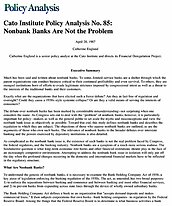Exactly what are the organizations that have elicited such a fierce debate? Are they in fact free of regulation and oversight? Could they cause a 1930s-style systemic collapse? Or are they a valid means of serving the interests of consumers?
The debate over nonbank banks has been marked by considerable misunderstanding–not surprising when one considers the name. As Congress sets out to deal with the “problem” of nonbank banks, however, it is particularly important for policy–makers as well as the general public to set aside the myths and misconceptions and view the nonbank bank issue as objectively as possible. Toward that end, this study defines nonbank banks and describes the regulation to which they are subject. The objections of those who oppose nonbank banks are outlined, as are the arguments of those who own such banks. The relevance of nonbank banks to the broader debates over interstate banking and the powers exercised by depository institutions is also detailed.
As complicated as the nonbank bank issue is, the existence of such banks is not the real problem faced by Congress, the federal regulators, and the banking industry. Nonbank banks are a symptom of a much more serious malaise. The fundamental question is what long-term economic role banks and other financial institutions should play in the face of an increasingly competitive environment. Attempting to address the nonbank bank issue in isolation will only put off the day when the profound changes occurring in the domestic and international financial markets have to be reflected in the regulatory structure.

